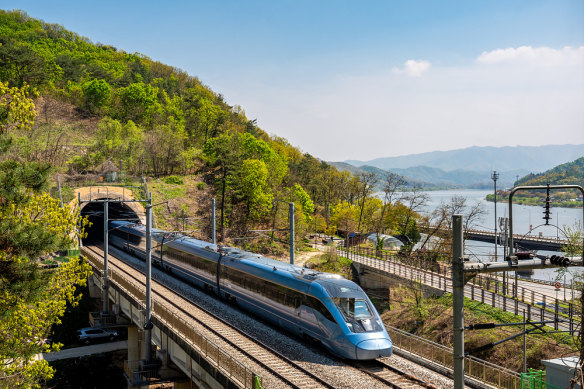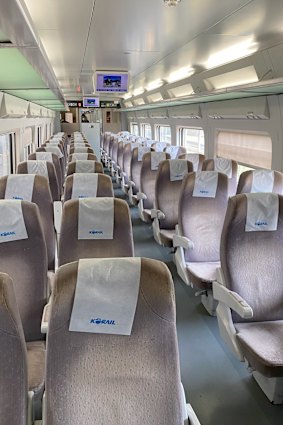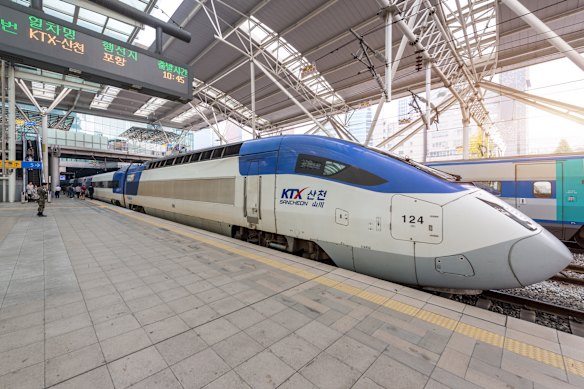This bullet train journey is something Australians can only dream of
By Craig Platt
The train: KTX, South Korea
- Route Seoul to Busan
- Distance 417 kilometres
- Operator KTX (Korean Train Express)
- Class Standard class
- Frequency 55 times a day (for the KTX)

On the bullet train from Seoul to Busan.
The journey
From Seoul Central Station to Busan Central on board the KTX bullet train, with a scheduled time of 2 hours, 15 minutes and a top speed of 330km/h. Linking South Korea’s two largest cities, it’s one of the busiest train routes in the country. The trip takes you through unappealing industrial towns between the two cities, though there are some more scenic views along the way of the hilly countryside and local farms. The ride is exceedingly smooth. Indeed it often feels like we’re barely moving at all, never mind zipping along at more than 300 km/h. Seats can be reserved but if you buy a non-reserved ticket at short notice you can still board – if there’s no seat available you’ll just have to hang out between the carriages, which quite a few passengers are doing on this trip.
The seat

Seats in the Standard cabin in a two by two format.Credit: Craig Platt
There are two classes to choose from: standard and first. The standard cabin offers a two-two configuration, while the first class seats are larger with more legroom and a one-two layout. I’m in standard for this journey and there’s plenty of legroom and space for my 182-centimetre frame. Standard class is available from about $59 one way or about $82 for first class. It’s relatively easy to book tickets via the korail.com site (once you switch the language to English) but in my case the tickets have been arranged by my tour guide from Inside Asia (who also helpfully insists on taking responsibility for getting our luggage on board).
Boarding
Departing from Seoul means the train sits at the platform for a while before it’s time to leave, so boarding is a leisurely affair (but don’t dawdle – the train leaves exactly on time). Luggage safely stowed on board, I have time to walk up to the engine and snap a pic of the train’s sleek nose before walking back to my carriage and finding my seat.
Baggage
There’s no weight limit on baggage, but you must be able to carry it yourself, you’re not allowed more than two items and you aren’t allowed to place them on a seat. For smaller items, there are racks above the seats in the carriage and storage shelves for larger bags at the end of the carriage. Despite the rule about lifting your own bags, a white-jacketed attendant shows no hesitation when an elderly passenger asks him to get her bag down from the rack.

A high-speed Korail train at the station in Seoul.Credit: iStock
Food + drink
There’s no dining car nor food trolleys, just a vending machine with a small selection of snacks and drinks. First-class passengers get a couple of biscuits and a packet of nuts, but if you’re in economy you’ll need to bring your own or eat at the station beforehand.
One more thing
South Korea has had bullet trains for just over 20 years, with the original designs based on the French TGV. Since then the number of high-speed lines has continued to expand, but one proposed line remains controversial – a rail connection from the mainland to Jeju Island, via underwater tunnel, has been under consideration for more than 10 years but the project has stalled. One reason for the original idea is the popularity of the destination: the busiest air route in the world is Seoul-Jeju.
The verdict
This is everything a bullet train journey should be – a fast way to connect two major centres, offering passengers comfort and a huge number of services at a reasonable price. The only thing lacking is on-board dining, but it’s still the type of experience we can only dream of in Australia.
Our rating out of five
★★★★
The writer travelled as a guest of Inside Asia (insideasiatours.com) and Visit Korea (english.visitkorea.or.kr).
Sign up for the Traveller newsletter
The latest travel news, tips and inspiration delivered to your inbox. Sign up now.